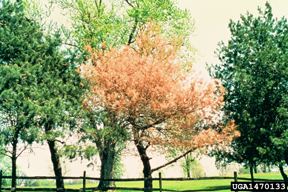Loss of exotic pines in Michigan from pine wilt disease
Non-native pines in Michigan landscapes are susceptible to the often fatal pine wilt disease caused by the pinewood nematode
|
Sudden wilt and death of pines in Michigan and across the Midwest may have been the result of a disease caused by pinewood nematodes, (Bursaphelenchus xylophilis). This parasitic nematode most commonly attacks non-native pines, such as Scotch and Austrian. Native pine species, white, red and jack are less susceptible to pine wilt disease. The disease was first identified in Michigan in 1980. The microscopic nematode is carried to the tree within breathing tubes of wood-boring beetles, especially the Sawyer beetle, (Monochamus sp.).
Sawyer beetles lay eggs into holes they gnaw in the bark of pine trees. They are attracted to pines weakened by drought, insect feeding and trees already infested with nematodes. Sawyer beetles also lay their eggs on freshly cut timber and stumps where bark remains attached. Nematodes exit the beetle’s breathing tubes and enter the tree through wounds created by the beetles during feeding and egg laying. Upon entering the plant, nematodes begin to attack and damage resin canals. The tree’s defensive response is to wall off the attacking nematodes, reducing the flow of resin. Reduced resin flow within the tree due to nematode feeding provides a safe site for beetle larvae to feed and develop.
The first visible symptom of the disease is the yellowing of needles on one or more branches. These branches die quickly and needles remain attached as symptoms spread through the whole tree, often killing it in 3 to 4 months. Larvae of the Sawyer beetle continue to feed and develop into adult beetles within the dying trees. Adult Sawyer beetles, emerging from nematode infested trees, carry the tiny roundworms to new trees where the cycle continues. Trees that have died should be cut down and the wood destroyed before the beetles emerge in early summer. If stumps are left behind, it is important to remove the bark to prevent egg laying by borers or to destroy young larvae of borers already present under the bark.
Confirmation of pine wilt disease can be obtained by submitting samples to the nematode lab at MSU’s Diagnostic Services. Samples should be taken from branches exhibiting early symptoms of yellowing needles. Sample branches should be 1 inch in diameter and at least 6 to 8 inches long. For more information on submitting samples visit the MSU Diagnostic Services.
Prevention of Pine Wilt Disease starts with good cultural practices that encourage healthy trees. Use of mulch, fertilization based on soil test results and providing water to pines during dry conditions can help maintain vigorous trees. Avoid planting non-native species of pines in the future. More in-depth information on Pine Wilt Disease can be found at: http://www.pestid.msu.edu/Portals/0/Factsheets/pinewilt_4page.pdf



 Print
Print Email
Email Scotch pine damaged by pinewood nematode.
Scotch pine damaged by pinewood nematode. 



